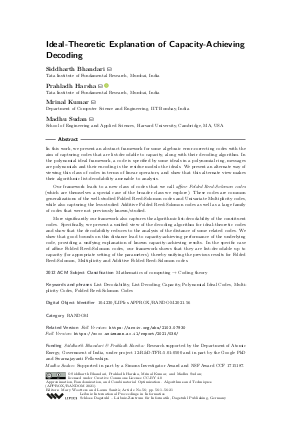Ideal-Theoretic Explanation of Capacity-Achieving Decoding
Authors
Siddharth Bhandari,
Prahladh Harsha  ,
Mrinal Kumar,
Madhu Sudan
,
Mrinal Kumar,
Madhu Sudan
-
Part of:
Volume:
Approximation, Randomization, and Combinatorial Optimization. Algorithms and Techniques (APPROX/RANDOM 2021)
Part of: Series: Leibniz International Proceedings in Informatics (LIPIcs)
Part of: Conference: International Conference on Randomization and Computation (RANDOM)
Part of: Conference: International Conference on Approximation Algorithms for Combinatorial Optimization Problems (APPROX) - License:
 Creative Commons Attribution 4.0 International license
Creative Commons Attribution 4.0 International license
- Publication Date: 2021-09-15
File

PDF
LIPIcs.APPROX-RANDOM.2021.56.pdf
- Filesize: 0.79 MB
- 21 pages
Document Identifiers
Related Versions
- Full Version https://arxiv.org/abs/2103.07930
- Full Version https://eccc.weizmann.ac.il/report/2021/036/
Subject Classification
ACM Subject Classification
- Mathematics of computing → Coding theory
Keywords
- List Decodability
- List Decoding Capacity
- Polynomial Ideal Codes
- Multiplicity Codes
- Folded Reed-Solomon Codes
Metrics
- Access Statistics
-
Total Accesses (updated on a weekly basis)
0Document
0Metadata
Abstract
In this work, we present an abstract framework for some algebraic error-correcting codes with the aim of capturing codes that are list-decodable to capacity, along with their decoding algorithm. In the polynomial ideal framework, a code is specified by some ideals in a polynomial ring, messages are polynomials and their encoding is the residue modulo the ideals. We present an alternate way of viewing this class of codes in terms of linear operators, and show that this alternate view makes their algorithmic list-decodability amenable to analysis. Our framework leads to a new class of codes that we call affine Folded Reed-Solomon codes (which are themselves a special case of the broader class we explore). These codes are common generalizations of the well-studied Folded Reed-Solomon codes and Univariate Multiplicity codes, while also capturing the less-studied Additive Folded Reed-Solomon codes as well as a large family of codes that were not previously known/studied. More significantly our framework also captures the algorithmic list-decodability of the constituent codes. Specifically, we present a unified view of the decoding algorithm for ideal-theoretic codes and show that the decodability reduces to the analysis of the distance of some related codes. We show that good bounds on this distance lead to capacity-achieving performance of the underlying code, providing a unifying explanation of known capacity-achieving results. In the specific case of affine Folded Reed-Solomon codes, our framework shows that they are list-decodable up to capacity (for appropriate setting of the parameters), thereby unifying the previous results for Folded Reed-Solomon, Multiplicity and Additive Folded Reed-Solomon codes.
Cite As Get BibTex
Siddharth Bhandari, Prahladh Harsha, Mrinal Kumar, and Madhu Sudan. Ideal-Theoretic Explanation of Capacity-Achieving Decoding. In Approximation, Randomization, and Combinatorial Optimization. Algorithms and Techniques (APPROX/RANDOM 2021). Leibniz International Proceedings in Informatics (LIPIcs), Volume 207, pp. 56:1-56:21, Schloss Dagstuhl – Leibniz-Zentrum für Informatik (2021)
https://doi.org/10.4230/LIPIcs.APPROX/RANDOM.2021.56
BibTex
@InProceedings{bhandari_et_al:LIPIcs.APPROX/RANDOM.2021.56,
author = {Bhandari, Siddharth and Harsha, Prahladh and Kumar, Mrinal and Sudan, Madhu},
title = {{Ideal-Theoretic Explanation of Capacity-Achieving Decoding}},
booktitle = {Approximation, Randomization, and Combinatorial Optimization. Algorithms and Techniques (APPROX/RANDOM 2021)},
pages = {56:1--56:21},
series = {Leibniz International Proceedings in Informatics (LIPIcs)},
ISBN = {978-3-95977-207-5},
ISSN = {1868-8969},
year = {2021},
volume = {207},
editor = {Wootters, Mary and Sanit\`{a}, Laura},
publisher = {Schloss Dagstuhl -- Leibniz-Zentrum f{\"u}r Informatik},
address = {Dagstuhl, Germany},
URL = {https://drops.dagstuhl.de/entities/document/10.4230/LIPIcs.APPROX/RANDOM.2021.56},
URN = {urn:nbn:de:0030-drops-147499},
doi = {10.4230/LIPIcs.APPROX/RANDOM.2021.56},
annote = {Keywords: List Decodability, List Decoding Capacity, Polynomial Ideal Codes, Multiplicity Codes, Folded Reed-Solomon Codes}
}
Author Details
Funding
Siddharth Bhandari & Prahladh Harsha: Research supported by the Department of Atomic Energy, Government of India, under project 12-R&D-TFR-5.01-0500 and in part by the Google PhD and Swarnajayanti Fellowships.
- Sudan, Madhu: Supported in part by a Simons Investigator Award and NSF Award CCF 1715187.
References
- Siddharth Bhandari, Prahladh Harsha, Mrinal Kumar, and Madhu Sudan. Ideal-theoretic explanation of capacity-achieving decoding. (manuscript). http://arxiv.org/abs/2103.07930, URL: https://eccc.weizmann.ac.il/eccc-reports/2021/TR21-036.
- Venkatesan Guruswami. Linear-algebraic list decoding of folded Reed-Solomon codes. In Proc. 26th IEEE Conf. on Comput. Complexity, pages 77-85, 2011. URL: http://dx.doi.org/10.1109/CCC.2011.22.
- Venkatesan Guruswami and Atri Rudra. Explicit codes achieving list decoding capacity: Error-correction with optimal redundancy. IEEE Trans. Inform. Theory, 54(1):135-150, 2008. (Preliminary version in 38th STOC, 2006). https://eccc.weizmann.ac.il/eccc-reports/2005/TR05-133, URL: http://dx.doi.org/10.1109/TIT.2007.911222.
- Venkatesan Guruswami, Amit Sahai, and Madhu Sudan. "Soft-decision" decoding of Chinese Remainder Codes. In Proc. 41st IEEE Symp. on Foundations of Comp. Science (FOCS), pages 159-168, 2000. URL: http://dx.doi.org/10.1109/SFCS.2000.892076.
- Venkatesan Guruswami and Madhu Sudan. Improved decoding of Reed-Solomon and algebraic-geometry codes. IEEE Trans. Inform. Theory, 45(6):1757-1767, 1999. (Preliminary version in 39th FOCS, 1998). https://eccc.weizmann.ac.il/eccc-reports/1998/TR98-043, URL: http://dx.doi.org/10.1109/18.782097.
- Venkatesan Guruswami and Carol Wang. Linear-algebraic list decoding for variants of Reed-Solomon codes. IEEE Trans. Inform. Theory, 59(6):3257-3268, 2013. (Preliminary version in 26th IEEE Conference on Computational Complexity, 2011 and 15th RANDOM, 2011). https://eccc.weizmann.ac.il/eccc-reports/2012/TR12-073, URL: http://dx.doi.org/10.1109/TIT.2013.2246813.
- Durga Datt Joshi. A note on upper bounds for minimum distance codes. Information and Control, 1(3):289-295, 1958. URL: http://dx.doi.org/10.1016/S0019-9958(58)80006-6.
-
Yasuo Komamiya. Application of logical mathematics to information theory. Proc. 3rd Japan. Nat. Cong. Appl. Math, 437, 1953.

- Swastik Kopparty. List-decoding multiplicity codes. Theory of Computing, 11:149-182, 2015. https://eccc.weizmann.ac.il/eccc-reports/2012/TR12-044, URL: http://dx.doi.org/10.4086/toc.2015.v011a005.
- Swastik Kopparty, Shubhangi Saraf, and Sergey Yekhanin. High-rate codes with sublinear-time decoding. J. ACM, 61(5):28:1-28:20, 2014. (Preliminary version in 43rd STOC, 2011). https://eccc.weizmann.ac.il/eccc-reports/2010/TR10-148, URL: http://dx.doi.org/10.1145/2629416.
- Richard Collom Singleton. Maximum distance q-nary codes. IEEE Trans. Inform. Theory, 10(2):116-118, 1964. URL: http://dx.doi.org/10.1109/TIT.1964.1053661.
- Salil P. Vadhan. Pseudorandomness. Found. Trends Theor. Comput. Sci., 7(1-3):1-336, 2012. URL: http://dx.doi.org/10.1561/0400000010.
